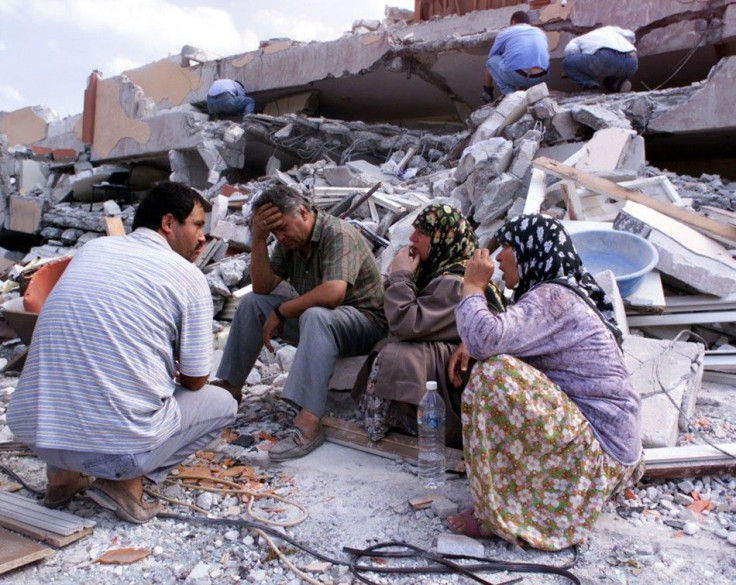Can Earthquakes be Predicted?

In Turkey, a 7.2 magnitude earthquake has left at least 270 people dead, most of whom were crushed when concrete buildings in the cities of Van and Ercis collapsed onto them. Rescue teams are currently digging threw rubble for survivors, but it is a slow and difficult process.
If people in southeastern Turkey had known about the quake in advance, they would have been able to flee their homes. While the destruction wouldn't have been abated, and people still rendered homeless by the tremors, significantly fewer lives could have been lost. The same could be said for the 2010 Haiti earthquake, which, in part due to the poor quality of many houses, killed upwards of 300,000 people.
Could the quakes have been predicted in advance?
That question is always asked after a devastating earthquake. Following a 7.4 magnitude earthquake near New Zealand's Kermadec Islands on Saturday and a destructive earthquake in Canterbury, New Zealand last Wednesday, scientists are being investigated by the Royal Commission of Inquiry to see if evidence of the earthquakes was withheld from the public.
Scientists argued that although there were signs that an earthquake might be coming, they thought that telling the public would incite unnecessary panic.
While there was a very small possibility of an earthquake over the original magnitude 7.1 quake the likelihood was so small it was not deemed necessary to make it public, GNS scientist Kelvin Berryman told TV NZ.
Italy has taken this theme to the next level, and seven Italian scientists and seismic experts are on trial for more than 300 counts of manslaughter.
Prosecutors claim that 308 people would still be alive if seismologists hadn't provided inexact, incomplete and contradictory information in the weeks leading up to the 6.3 magnitude earthquake in L'Aquila in 2009. Like in Turkey, nearly 11,000 damaged and collapsed buildings crushed people in the medieval city outside of Rome.
It is a trial that has scientists all over the world in an uproar, NewsHour science correspondent Miles O'Brien said last week. Many [in Italy] are comparing it to the trial of Galileo in 1633. He was found guilty of heresy for suggesting the Earth wasn't the center of the universe.
The Italian seismologists face up to 15 years in prison or the possibility of paying for $31.6 million in damages.
While there has been one enormously successful earthquake prediction -- the 7.3 magnitude quake in Haicheng earthquake in 1975, which was accurately predicted to the day by a Chinese seismologist, who called for an evacuation and saved thousands of lives -- most scientists agree that infallible earthquake prediction is nearly impossible.
We just have a very difficult time now determining what's happening before an earthquake, what's just sort of part of the natural complexity of changes that are going on in the earth or around faults before an earthquake. And we haven't been able to find that sort of magic precursor, Japanese seismologist Jim Mori told NPR.
Nonetheless, there was an advanced warning before the L'Aquila quake. It happened on Italian television one month before the 6.3 magnitude earthquake. A lab technician named Giampaolo Giuliani used a radon emission test to determine that a major earthquake was coming to central Italy. Labeled an alarmist, he was censured by the Italian government and his findings were removed from the internet.
As scandalous as it sounds, the prediction wasn't worth much. Radon tests have a low success rate and aren't popular in the seismic community, according to the New York Times. Additionally, Giuliani's study lacked some key information.
In response to Guiliani's prediction, Italy's Great Risks Commission issued a memo just one week before the L'Aquila quake that said a major earthquake was improbable. The commission, from which six members are now on trial, did add that it couldn't totally rule out the chance that a quake would hit.
I'm afraid that like an earthquake, nothing in this case is predictable, one of the defendant's lawyers, Marcello Milandri, told BBC.
Let's not forget, this trial is happening in L'Aquila, where the entire population has been personally affected, and awaiting a sentence that should not happen, but could happen.
Still, neither the trial nor poor results have stopped scientists from trying to refine earthquake prediction methods. NASA and the University of California, Davis conducted a four year study on forecasting the location of quakes of magnitude 4.95 or higher, and were 10 times more accurate at predicting quakes' locations than random guessing would be.
These forecasts are helping guide our data collection efforts by focusing our attention on regions with higher earthquake probability, said Andrea Donnellan of NASA's Jet Propulsion Laboratory. This approach worked well for capturing the motions of the 2010 magnitude 7.2 El Mayor-Cucupah earthquake in Mexico's Baja California using NASA's Uninhabited Aerial Vehicle Synthetic Aperture Radar.
But that isn't accurate enough. Not to be certain. So scientists are trying to refine their techniques. In Japan, the government spends about $100 million a year to fund seismic research. Much of this money has gone into a sophisticated early warning system, which can't predict quakes, but can warn Japanese citizens as soon as one hits the country.
The alerts go to the media, millions of cell phones and automatically stop elevators, hazardous industrial mechanisms and bullet trains. Here is how it works. Every earthquake creates a primary or P-wave and a secondary or S-wave. The latter does the damage. The former, only detectable by seismometers, has a much smaller amplitude and thus moves much faster, Japanese Meteorological Agency chief Akihiko Wakayama told NPR last Thursday.
Perhaps it would be better for Italian authorities to spend their money on an early warning system than for a lengthy trial.
© Copyright IBTimes 2025. All rights reserved.





















